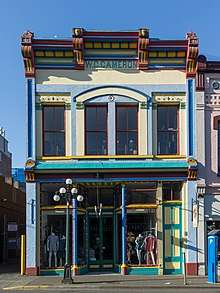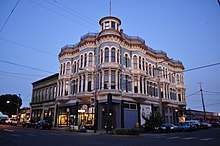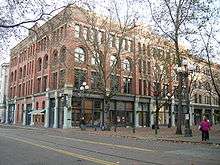Elmer H. Fisher
Elmer H. Fisher (1840–1905) was an architect best known for his work during the rebuilding of the American city of Seattle after it was devastated by fire in 1889. He began his career as a carpenter and migrated from Massachusetts to the Pacific Northwest, where he practiced architecture from 1886 to 1891. After his reputation was damaged by personal scandal in Seattle, he relocated to Los Angeles in 1893 where he only had modest success as an architect before returning to carpentry, passing away in 1905. His commercial building designs played a major role in reshaping Seattle architecture in the late 19th century and many still survive as part of the Pioneer Square Historic District.
Elmer H. Fisher | |
|---|---|
.jpg) San Francisco Journal of Commerce Publishing Co., 1890 | |
| Born | c.1851 Royalston, Massachusetts (possibly) |
| Died | 1905 Los Angeles, CA United States |
| Occupation | Architect |
| Buildings | Pioneer Building Austin A. Bell Building |
Life
.jpeg)
Fisher claimed he was born in Scotland in 1840 and immigrated to Massachusetts at age 17 where he received an architectural apprenticeship in Worcester though this and his claims of living in Butte, Montana have yet to be substantiated by research.[lower-roman 1][1] In the 1870s he moved west to Minnesota, where he first appeared in the 1874 Minneapolis City Directory as a cabinet maker,[2] the following year as a sash maker for R.P. Russell & Co.,[3] and the year after as a moulder for Smith, Parker & Co.[4] He continued his journey west, arriving in Denver, Colorado around 1880[lower-roman 2] where after first working as a foreman for a sash & door factory,[5] began trading as an architect as well as a carpenter and builder with partner J.H. Corrin until his departure from that city in 1885.[6][7]
He arrived in the Pacific Northwest in early 1886 where he established an architectural office in Victoria, British Columbia. Business in the booming city was brisk and within a year he had multiple substantial business buildings and homes to his credit and began receiving commissions further afield in Vancouver, British Columbia and Port Townsend, Washington.[1] Around this time he received his first major commissions in Seattle including the first Korn Block (1888, Destroyed) and 1st Regiment Army Hall (1888, Demolished), giving him a foothold in the competitive architectural scene there. Seeing the great potential and growth happening in Seattle, Fisher left Victoria and established a permanent Seattle office where he began receiving large projects immediately including the Austin A. Bell Building, the Gilmore & Kirman Building and Henry Yesler's Pioneer Building. By early 1889 Fisher employed 4 architects at his James Street office and was so busy that small-scale commissions were turned away.[8]
While the first few months of 1889 were some of Fisher's busiest, he and every other hopeful architect in the city would be given a clean slate when the Great Seattle fire of June 6, 1889 wiped out the majority of the business district. Many of Fisher's recent commissions were either outside of the burnt district or were only in the excavation stages at the time of the fire and despite common belief, many of his most famous buildings would have been built whether Seattle burned or not. Regardless, new commissions in the wake of the fire were numerous to the degree that several pre-fire commissions were halted or left un-built due to the glut of new construction.[9] He is still considered the most prolific of the architects involved in rebuilding the city for designing almost half of the major downtown buildings between 1889 and 1891.
Due to financial problems and a variety of legal claims laid against him, he left his career as an architect by 1891 to run a hotel that he had previously designed and built.[10]
In 1893, a former mistress brought a civil suit against Fisher. Although he was acquitted, the scandal ruined his reputation. He had the contents of his Seattle home and office auctioned off and permanently removed to Los Angeles where he formed a new partnership with Carroll H. Brown. In Los Angeles he struggled to re-establish the career success he had enjoyed in Seattle, which had less to do with his reputation and more as a result of the Panic of 1893 which halted building projects across the nation. After a major commission for the Van Nuys Building in downtown Los Angeles fell through, his partnership with Brown was dissolved and he all but retired from architecture. He returned to his first profession, carpentry, last appearing in the Los Angeles city Directory in 1902.[11] He passed away in 1905 in relative obscurity. His final resting place is unknown.
Work
Fisher's early commercial designs were of Victorian and Italianate influence and were typified by exposed brick with corbelling, selective exterior plastering and massive Aedicular window surrounds. Romanesque elements heavily utilizing decorative terra cotta began to make their way into his designs by 1888 and would play a major role in his later work, such as the now demolished Burke block (1889-91), whose many elaborate terra cotta elements were incorporated into the public plaza surrounding the Henry M. Jackson Federal Building (1975).
On June 6, 1889, a fire destroyed most of Seattle's business district. The buildings were primarily constructed of wood so the large-scale rebuilding campaign focused on new "fireproof" buildings constructed of brick, stone and iron. Fisher designed many of the new buildings and some can still be seen in what is now the Pioneer Square neighborhood.[12]
Fisher favored the Richardsonian Romanesque style which led to a unity of appearance in the district.[12] He also tended to divide the facades of his buildings into a grid, a style influenced by Victorian architecture.[13]
His best-known work is the Pioneer Building in Seattle. Designed and first proposed in 1888, It was completed in 1892 for Henry Yesler and it served as a "prestige office address" throughout the decade.[14][15] It won an award from the American Institute of Architects for "being the finest building West of Chicago".[16]
Projects




.jpeg)

Pre-Fire
- Spencer's Arcade (1886, Destroyed) - Government & Broad St, Victoria, BC[17]
- Stelly Block [Clarence Hotel] (1886-7, Demolished) - Johnson & Blanshard St, Victoria, BC
- Denny Building (1886-7, Destroyed) - Broad St, Victoria, British Columbia[18]
- Reid Residence (1886, Demolished?) - Esquimalt Road, Victoria, BC[18]
- McCurdy Block (1887) - Water St & Taylor St, Port Townsend, WA[19]
- Goldstream Hotel (1887, Destroyed) - Langford, BC
- 2 Houses for A.J. Langley (1887) - 1133 & 1141 Fort St, Victoria, BC
- Byrnes Block (1887) - Vancouver, British Columbia
- Willie Bakery (1887) - 537 Johnson St, Victoria, BC
- Seavy Block (1887, Destroyed) - Water St, Port Townsend, Washington
- Bank of British Columbia (1887, Destroyed) - Columbia & Mary St, New Westminster, British Columbia
- McLennan & McFeely Block (1887-8, Demolished) - 132 Cordova St, Vancouver, BC
- Pimbury Block (1887-8, Demolished) - Nanaimo, British Columbia[20]
- Cameron Bldg (1888) - 581 Johnson St, Victoria, BC
- Young Building (White House) [New Facade] (1888, Demolished) - 67 Government St, Victoria, BC
- Sheam & Lee Building (1888) - 539-45 Fisgard St, Victoria, BC
- Craft & Norris Block (1888, Altered) - 95 Douglas St, Victoria, BC
- Armory Hall (1888, Destroyed) - Union Ave near 4th St, Seattle, WA
- Bow Block (1888, Destroyed) - 314 1st Ave S, Seattle, WA
- Korn Block (1888, Destroyed) - 119 Yesler Way, Seattle, WA
- James & Hastings Building (1889) - 940 Water St, Port Townsend, WA
- N.D. Hill Building (1889) - 635 Water St, Port Townsend, WA
- Pioneer Building (1889–91) - 600 1st Ave, Seattle, WA
- Gilmore & Kirkman Building (1889–90, Destroyed) - 1225 1st Ave, Seattle, WA[21]
- Y.M.C.A. Building (1889, only 1 floor built, demolished) - 1417 1st Ave Seattle, WA[22][23]
- Scurry Terrace (1889, Demolished) - 3rd Ave & Cherry St, Seattle, WA[21]
- Howard Lewis Residence (1889, Demolished) 10th Ave & James Street, Seattle, WA
- Burke's 'New York Building' (1889–90, Demolished) 2nd Ave & Marion Street, Seattle, WA[21]
- Burke Building No.2 [The Burke] (1889, Demolished) 3rd Ave & Marion St, Seattle, WA
- Denny Hotel (1889, Unbuilt)[8] Denny Hill, Seattle, WA
- Austin A. Bell Building (1889–90) - 2330 1st Ave, Seattle, Washington[21]
- Hastings Building (1889) - 899 Water St, Port Townsend, WA
- Sullivan Building (1889, Unbuilt) - NE corner Occidental Ave S & Main St, Seattle, WA[21]
- Gatzert & McDonald Building (1889, Unbuilt) SE corner 1st Ave & Madison St, Seattle, WA[21][24]
- Hull Building (1889) - 2405 1st Ave, Seattle, WA[21]
Post-Fire
- Scheuerman Block (1889–90) - 110 Cherry St, Seattle, WA
- Lowman & Hanford Building/Puget Sound Bank (1889, Demolished) 1st & Cherry, Seattle, WA[21]
- Naher Terrace (1889, Demolished) - Yesler Way near 7th Ave, Seattle, WA[21]
- Pease Building (1889, Demolished) - 1st Ave & Lenora St, Seattle, WA[21]
- T. O'Brien Residence (1889, Demolished) - 9th Ave & King St, Seattle, WA[21]
- Seattle Times Building (1889, Demolished) - 113 Columbia St, Seattle, WA[21]
- Methodist Protestant Church (1889–90, Demolished) - 3rd Ave & Pike St, Seattle, WA[21]
- Trinity Episcopal Church (1889–90, Demolished) - 8th Ave & Cherry St, Seattle, WA[21]
- Haller Block (1889–90, Destroyed) - 801 2nd Ave, Seattle, WA[21]
- Starr-Boyd Bldg (1889–90, Destroyed) - 621 1st Ave, Seattle, WA[21]
- Schwabacher Building (1889–90, altered) - 1st Ave S & Yesler Way, Seattle, WA[21]
- Rengstorff Building (1889–90, Destroyed) - 815 2nd Ave, Seattle, WA[21][25]
- New England Hotel (1889–90, Altered) - 219 1st Ave S, Seattle, WA[21]
- Korn Block (1889–90) - 119 Yesler Way, Seattle, WA[21]
- Feurer Building (1889–90) - 88 Yesler Way, Seattle, WA[21]
- Douthitt Building (1889–90, Demolished) - 2nd Ave north of Columbia, Seattle, WA[21]
- Washington Building (1889–90, Destroyed) - 700 Block 1st Ave, Seattle, WA[21]
- Sullivan Building (1889–91, Destroyed) - 714 1st Ave, Seattle, WA[21][26]
- Scurry Residence (1890, Demolished) - 11th Ave & James St, Seattle, WA[21]
- Fisher Building (1889–90, Demolished) - 3rd Ave & Pike St, Seattle, WA[21]
- Bank of Commerce (1889–90) - 1st Ave & Yesler Way, Seattle, WA
- Yesler Building [Mutual Life Building] (1889–90, 1 floor of original design built) - 605 1st Ave, Seattle, WA
- E.H. Fisher Residence (1890–91, status unknown) - West of Yakima, WA[27]
- Lottie Roth Block (1890–91) - W Holly St at G St, Bellingham, WA
- State Building (1890–91) - 300 Occidental Ave S, Seattle, WA
- J.W. George Building [Lebanon Building/Tourist Hotel] (1890–91, Destroyed) - 224 Occidental Ave S, Seattle, WA[21]
Brown & Fisher, Los Angeles
- Griffith Block (1894, Demolished) - Azusa Ave, Azusa, CA
- 2 Houses for John Wallenslager (1894, possibly still standing) - W 17th & Toberman St, Los Angeles, CA
- Geo S. Gregson Residence (1894-5, status unknown) - Harper Tract, Los Angeles, CA
- 2 story building for J.W. Hinton (1894, status unknown) - Santee St, Los Angeles, CA
- Cottage for Emerson (1895, status unknown) - near Pico St, Los Angeles, CA
- D.A. Crichton Residence (1895, Demolished) - Flower St, near 15th, Los Angeles, CA
- Van Nuys Building (1895, unbuilt) - 4th & Main St, Los Angeles, CA[28]
- Meek's Bakery Co. (1896, Demolished) - 6th & San Pedro St, Los Angeles, CA[29]
Notes
- According to Massachusetts State Birth records, an Elmer Fisher was born on August 6, 1851 near Royalston, Massachusetts to parents Horace and Lucy Jane Fisher. This Elmer next appears in the 1865 Massachusetts State Census living with his family on a farm near Royalston, which confirms his father's birth place to also be Massachusetts and Elmer's middle initial to be "H", likely for "Horace". He appears in the 1870 United States census as a farm laborer living as a boarder in Orange, Massachusetts
- By the time of the 1880 census, Elmer's given age was 36, a seven year discrepancy, and his parent's birth place had changed to Scotland, though his own birth place was still listed as Massachusetts
References
| Wikimedia Commons has media related to Elmer H. Fisher. |
- "Summary for 300 Occidental Way / Parcel ID 5247800695". City of Seattle Department of Neighborhoods. Retrieved September 24, 2009.
- Minneapolis City Directory. Minneapolis: Campbell & Davison. 1874. p. 162. Retrieved 7 August 2018.
- Minneapolis City Directory. Minneapolis: W.M. Campbell. 1875. p. 172. Retrieved 7 August 2018.
- Minneapolis City Directory. Minneapolis: Campbell & Davison. 1876. p. 130. Retrieved 7 August 2018.
- Corbett & Ballenger's 9th Annual Denver City Directory (9 ed.). Denver: Corbett & Ballinger. 1881. p. 216. Retrieved 7 August 2018.
- Corbett & Ballinger's Eleventh Annual Denver City Directory. Denver: Corbett & Ballinger. 1883. p. 143. Retrieved 7 August 2018.
- Corbett & Ballenger's 12th Annual Denver City Directory (12th ed.). Denver: Corbett & Ballenger. 1884. p. 202. Retrieved 7 August 2018.
- "A Complementary Letter - The Denny Hotel Committee's Tribute to Architect Fisher's Skill". The Seattle Post-Intelligencer. Library of Congress. 6 Feb 1889. Retrieved 9 September 2019.
- "Summary for 119 Yesler Way / Parcel ID 5247800545". City of Seattle Department of Neighborhoods. Retrieved September 24, 2009.
- "Summary for 105 1st Ave / Parcel ID 5247800046". City of Seattle Department of Neighborhoods. Retrieved September 24, 2009.
- Los Angeles City Directory. Los Angeles: Los Angeles City Directory Co. 1902. p. 391. Retrieved 15 August 2018.
- "Pioneer Square-Skid Road Historic District". National Park Service. Archived from the original on January 14, 2010. Retrieved September 24, 2009.
- "Summary for 219 1st Ave / Parcel ID 5247800105". City of Seattle Department of Neighborhoods. Retrieved September 24, 2009.
- "Yesler's Six-Story Block". The Seattle Post-Intelligencer. Library of Congress. 4 Dec 1888. Retrieved 25 July 2018.
- "Pioneer Building". National Park Service. Archived from the original on September 1, 2009. Retrieved September 24, 2009.
- "Summary for 606 1st Ave / Parcel ID 0939000150". City of Seattle Department of Neighborhoods. Retrieved September 24, 2009.
- "Spencer's New Building". Daily British Colonist. Victoria Newspapers 1858-1936. 30 Mar 1886. Retrieved 25 July 2018.
- "New Buildings". Daily British Colonist. Victoria Newspapers 1858-1936. 22 May 1886. Retrieved 25 July 2018.
- "From Yesterday's Daily". Weekly Puget Sound Argus. Washington State Library. 13 Jan 1887. Retrieved 24 April 2020.
- "Architect's drawing of a building with sign for E. Pimbury and Company, Victoria, British Columbia, between 1880 and 1890". University of Washington Special Collections. Retrieved 4 May 2020.
- "Two and a Half Million; Fisher's List of Buildings for the Past Year". The Seattle Post-Intellignecer. Library of Congress. 1 Jan 1890. Retrieved 1 August 2018.
- "Young men's Christian Association (YMCA) Building, probably 1890". University of Washington Special Collections. Retrieved 17 October 2019.
- "YMCA building at 1417 1st Ave., Seattle, 1903". University of Washington Special Collections. Retrieved 17 October 2019.
- "Gatzert & McDonald Block". University of Washington Special Collections. Washington Magazine. Retrieved 17 October 2019.
- "Rengstorff Block and Building, probably 1890". University of Washington Special Collections. Retrieved 4 May 2020.
- "Sullivan Building, probably 1891". University of Washington Special Collections. Retrieved 4 May 2020.
- "Local Brevities". The Yakima Herald. Library of Congress. 2 Jan 1890. Retrieved 29 July 2018.
- "Real Estate and Building". Los Angeles Herald. Library of Congress. 23 Mar 1895. Retrieved 29 July 2018.
- "Real Estate and Building - Uncontracted Work". Los Angeles Herald. Library of Congress. 27 Dec 1895. Retrieved 29 July 2018.
External links
- Goldstream Hotel, Langford - BC Archives
- Bank of British Columbia, New Westminster - BC Archives
- Stelly Block [Clarence Hotel], Victoria - University of Washington Digital Collections
- Pimbury Block, Nanaimo - BC Archives
- H. Young & Co. Building (White House), Victoria - BC Archives
- Craft & Norris Block, Victoria - BC Archives
- Armory Hall, Seattle - University of Washington Digital Collections
- 1st Korn Block, Seattle - University of Washington Digital Collections
- Gilmore & Kirkman Building [Arlington Hotel], Seattle - University of Washington Digital Archives